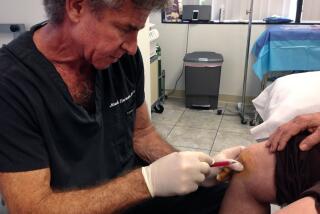Court Voids FDA Rule Allowing Use of Two Dyes in Cosmetics
WASHINGTON — A federal appeals court on Friday declared unlawful the Food and Drug Administration’s decision allowing the use in cosmetics of two dyes that contain traces of cancer-causing chemicals.
The U.S. Circuit Court of Appeals here ruled that the FDA had violated what is known as the Delaney Clause that bars cancer-causing substances in dyes and food additives, even though the judges agreed with the agency’s determination that the risk posed by dyes Orange No. 17 and Red No. 19 was extremely minimal.
The three-judge panel rejected the Reagan Administration’s argument that the FDA could allow the use of dyes that had virtually no risk because they contained only barely detectable traces of cancer-causing substances.
‘Alarmed About Risks’
“Congress, and the nation in general (at least as perceived by Congress), appear to have been truly alarmed about the risks of cancer,” the court said.
The court invalidated a 1986 FDA ruling that Orange No. 17 and Red No. 19 could be used in cosmetics because the cancer risk was “so trivial as to be effectively no risk.”
The FDA had cited a scientific panel’s finding that the lifetime risk for cancer was one in 19 billion for the orange dye and one in 9 million for the red dye.
“This is probably the most important food and drug case in many years,” said William B. Schultz, an attorney for Public Citizen Litigation Group, a consumer-advocacy organization. He said it thwarts the Administration’s attempt to do away with the Delaney Clause.
FDA spokesman Emil Corwin said agency officials had no immediate comment on the decision, but a spokeswoman for the Cosmetic, Toiletry and Fragrance Assn. said the trade group may appeal
More to Read
Sign up for Essential California
The most important California stories and recommendations in your inbox every morning.
You may occasionally receive promotional content from the Los Angeles Times.









